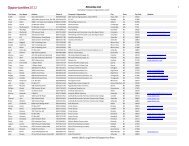Capital Opportunities for Small Businesses - sbtdc
Capital Opportunities for Small Businesses - sbtdc
Capital Opportunities for Small Businesses - sbtdc
You also want an ePaper? Increase the reach of your titles
YUMPU automatically turns print PDFs into web optimized ePapers that Google loves.
C A P I T A L O P P O R T U N I T I E S F O R SMA L L B U S I N E S S E S<br />
Asset-based lending is especially useful when the company confronts issues such as high growth or seasonal<br />
variations in business. In these environments, traditional unsecured lending is unlikely to satisfy all financing<br />
needs, and asset-based lending becomes a viable alternative. This method of lending is generally focused on<br />
providing secured working capital loans (with the amount that can be borrowed determined by established<br />
percentages of the advance against accounts receivable or inventory). By borrowing against its accounts<br />
receivable, a company can accelerate its cash collection cycle and improve its ability to purchase additional<br />
inventory to build sales. The resulting improvement in cash flow can be accomplished without giving up any<br />
ownership control.<br />
In a traditional arrangement, the asset-based lender extends credit usually against 80 percent of eligible<br />
receivables and 20 percent serving as a reserve, but percentages may vary. Eligibility is generally determined by<br />
the quality of the receivable. As the invoices are paid, the amounts received are applied against the borrower’s<br />
loan.<br />
Purchase order financing is another example of asset-based lending. This may be attractive to a company<br />
that has stretched its credit relations with vendors and has reached its lending capacity at the bank. The<br />
inability to finance raw materials to fill all orders would leave a company operating under capacity. The assetbased<br />
lender finances the purchase of the raw material, and the purchase orders are then assigned to the<br />
lender. After the orders are filled, payment is made to the lender, and the lender then deducts its costs and fees<br />
and remits the balance to the company.<br />
The interest cost of this source of financing can be relatively expensive. Terms can be as low as prime plus three<br />
percent, but can also be as high as prime plus ten percent. Asset-based lenders usually require first liens on<br />
assets and almost always require personal guarantees. Lenders may also move quickly to liquidate collateral<br />
where necessary. The advantage of this type of financing is that it is available to companies with a strong asset<br />
base but with insufficient cash flow to qualify <strong>for</strong> a traditional loan.<br />
Asset-Based Lender Members of the Carolinas Chapter<br />
of the Commercial Finance Association<br />
Bank of America Commercial Finance<br />
Business Credit Division<br />
101 South Tryon St., NC1-002-30-23<br />
Charlotte, NC 28255<br />
704.386.8956<br />
www.bankofamerica.com<br />
Branch Banking & Trust Co. (BB&T)<br />
200 W. 2 nd St., POB 1245<br />
Winston-Salem, NC 27101<br />
336.733.2724<br />
www.bbandt.com<br />
Business Alliance <strong>Capital</strong> Corp.<br />
214 Carnegie Center, Suite 302<br />
Princeton, NJ 08540<br />
609.897.8940 or 800.246.1089<br />
www.BACCORP.com<br />
CIT Commercial Credit<br />
2 Wachovia Center<br />
301 South Tryon St.<br />
Charlotte, NC 28202<br />
704. 339.2928<br />
www.cit.com<br />
The Commercial Finance Group<br />
230 Pond View Lane<br />
Fort Mill, SC 29715<br />
25









